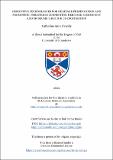Disruptive technologies for heritage preservation and promotion : strategies connecting heritage, community and museums through 3D digitisation
Abstract
Heritage is the physical evidence of human existence and expression with resounding benefits to society and communities. However, an ever-changing world presents constant threats, risking heritage’s destruction or loss. 3D digitisation preserves physical heritage through its reconstitution to digital, augmenting the potential for dissemination within the digital domain. A disconnect between museums and emergent technologies presents a challenge for democratised 3D digitisation and management. Yet, museums and their communities are agents for transformation invested in heritage permanence, with digital literacies to suggest synergies with adapted 3D processes and engagement. An opportunity for intervention to support preservation of heritage through 3D digitisation while facilitating its promotion through engagement with emergent and immersive technologies is investigated in this thesis. Unexpectedly, COVID-19 caused major global disruption, threatening to destabilise connections to heritage and undermine functionalities of museums within their communities. Response to COVID-19 initiated innovation, leading to modified design for applicable stakeholder response. This dissertation investigates how application of accessible strategies empowers communities to actively engage with their heritage as 3D digital assets in a time of disruption.
Practice-based research methodologies informed collaborative innovation with stakeholders and end users at various intersections of 3D preservation and promotion. Design of infrastructures and processes aid in engagement through laboratory research, deployed
prototypes, and recognition of demands from COVID-19. Strategies for Preserving Heritage through Engagement Representation and Archiving (SPHERA) supports engagement with 3D assets through its Pillars, including creation of digital content, digital skills development and knowledge exchange, and infrastructures to facilitate digital heritage curation and engagement. Guiding Principles and best Practice workflows support implementation of SPHERA as part of original contributions for this dissertation. Leveraging emergent technologies for communities and museums to preserve and promote heritage improves engagement and accessibility with consequential social benefits and wellbeing, and is an area of potential for the future.
Type
Thesis, PhD Doctor of Philosophy
Rights
Creative Commons Attribution-NonCommercial-NoDerivatives 4.0 International
http://creativecommons.org/licenses/by-nc-nd/4.0/
Collections
Except where otherwise noted within the work, this item's licence for re-use is described as Creative Commons Attribution-NonCommercial-NoDerivatives 4.0 International
Items in the St Andrews Research Repository are protected by copyright, with all rights reserved, unless otherwise indicated.


